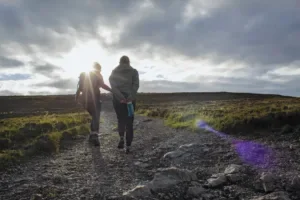This isn’t fiction and these aren’t actors. The torture is real.
The film is “¡Ya Basta!” (“Enough!”), and it’s a disturbing, intimate documentary of an epidemic of kidnappings and related crimes that started in Mexico in the ’90s.
The film was directed by University of Texas at Austin educational psychology Professor Ricardo Ainslie, and it’s not the first record he’s made of a community in crisis. It’s just the first time the community has been his hometown.

Ainslie, who has a dual U.S. and Mexican citizenship, was born and raised in Mexico City and remembers it as a wonderful place to be a kid. The streets were bustling, children played outside past dusk, neighbors stopped to chat, families felt safe in their homes.
In 2004, after being away from his native town for several years, Ainslie revisited Mexico City and was chilled to see the empty streets, apprehension in friends’ eyes, the armored cars, elaborate home security systems and bodyguards.
“During my visit, I heard horror stories from friends and family about the chaos, fear and explosion of kidnappings,” said Ainslie. “Everyone knew of someone who had been kidnapped in the previous 10 years.”
According to Ainslie, the kidnappings began in the early ’90s as a financially lucrative enterprise executed by sophisticated criminal groups who knew there was little risk of prosecution. The kidnappers targeted the very wealthy and demanded large ransoms–in one instance $22 million–which they often got.
The rich started adapting their lifestyles accordingly and protecting themselves with cadres of bodyguards, armored cars and expensive home security systems. They learned the police were as likely as not to bumble a rescue and get a kidnapped family member killed or be in cahoots with the kidnappers. No one was to be trusted. Bank officials sometimes sold kidnappers’ information about a family’s assets, and domestics could be persuaded to share details about a family’s comings and goings.
With the wealthy getting wiser and more insulated, kidnapping became democratized and a new breed of smalltime kidnappers emerged. This new group of kidnappers threw their net a bit wider, nabbing victims from the middle class or lower and asking for smaller ransoms. More people were being affected by the crime and these new victims didn’t have the resources to protect themselves.

“There was chaos and confusion, and the normal citizen didn’t have anyone to turn to for protection,” said Ainslie. “This all is happening in an environment of poverty and not much social mobility. These smalltime kidnappers could ask for as little as $50 or $100 per victim and still make more than they could make committing burglaries or running a taco stand.
“And the judicial system was and is in a state of flux, very antiquated, with practices and a structure that dates back to the Inquisition. Unless someone is caught red-handed, in the act of committing a crime, it’s unlikely they’ll ever be prosecuted. All of this is gradually getting better, but change is slow in coming. In 2009, Mexico’s violence and desperation is the lead story on CNN, but in 2004, most people in the U.S. didn’t know what was happening.”
After Ainslie’s visit to Mexico City, he was determined to share what he had seen with a broader audience, hoping the exposure “might become part of the national dialogue in Mexico and help the country move toward solutions.”
Ainslie decided to produce a documentary film that was raw, true and balanced. It would describe the improvements and give credit where credit was due, but also shine a light on what were dire circumstances for far too many.
As he started puzzling out the logistics, he realized he’d need to gain access to as many key players as possible, even if it were dangerous to do so. Taking a bare bones approach, he funded the first two years of the project out of his own pocket and traveled to Mexico with only two crew members–his son Roberto, and Jorge Sanhueza-Lyon and Ty Roberts, who were directors of photography during different stages of the project.
For an American it may be hard to imagine an environment in which kidnappings are so pervasive that family and friends can direct you to at least one victim, but that’s exactly how it panned out for Ainslie. He was able to include five interviews with kidnapping victims in his documentary as well as an interview with a father who paid the ransom for his kidnapped daughter. The abductors killed the young woman nevertheless.

Dual citizenship helped Ainslie build rapport and gain an audience with officials and experts who otherwise might have shunned him. As he put it, the reasonably warm welcome also was because “the government is not keen on this kind of publicity.” With finesse, diplomacy and luck, Ainslie was able to interview members of the Mexican equivalent of the American FBI, top government officials, state police, Mexican journalists and academics, family members of victims, the victims themselves and a kidnapper.
“There obviously was the potential for danger, and there were two moments in this project that were particularly tense,” said Ainslie. “The first was when I was taken by a police officer in ordinary street clothes to interview a kidnapper being held under guard in a seedy hotel. In some of the rooms off a dimly lit corridor there were men whom I assumed were also plainclothes police–most had weapons–but the setting was quite surreal and it was difficult to find one’s bearings in it.
“When you’re doing a documentary that addresses the fact of police corruption and law enforcement’s complicity in kidnappings, it can be unsettling to find yourself in a situation that is so sketchy and perhaps ‘off the books.’ The second tense incident was when I went with a man to the safe house where his daughter had been held in a very poor neighborhood where family members of the kidnappers still lived.”
If it sounds like Ainslie put himself in more danger than it was worth, then you don’t know the whole story. Or Ainslie.
Granted, the topic touched his personal life and appealed to his social consciousness, which extends beyond his own backyard, but he’s also a scholar who for 15 years has studied communities’ responses to crisis and catastrophe.

When national media converged on the tiny West Texas town of Anson to cover a raging argument over whether or not dancing should be allowed, Ainslie saw beyond the voyeuristic appeal of the debate. He wrote a book called “No Dancin’ in Anson” and peeled back layer after layer of racial, social and economic tensions that had sealed a community for decades.
When Jasper, Texas, suddenly gained worldwide notoriety as the little town where white racists chained an African American man behind a truck and dragged him until he was dead, Ainslie again felt that familiar curiosity about the underlying causes and how a community handles the fallout after tragedy. He wrote “Long Dark Road: The Story of Bill King and Jasper’s Murder,” “The Road to Redemption,” several scholarly articles and put together a traveling photographic exhibit related to his work in Jasper.
“With ‘¡Ya Basta!’ you have the story of the kidnapped and the kidnappers, but you also have the collective thoughts and feelings of a much larger group–you have a whole country living like victims,” says Ainslie. “What really fascinated me was what brought the national outrage to a boiling point and how the masses responded to not being able to walk the streets at night and having to hire bodyguards if they could afford them.”
The critical incident–the tipping point–turned out to be the 2004 kidnapping of two brothers who were held for $500,000. The ransom was paid, but the brothers were shot anyway, and the boys’ parents were assaulted as they were heading to their sons’ funeral.
It wasn’t that someone’s brother or son had never been kidnapped before. It wasn’t even that these were the first victims to be murdered after a ransom was paid. It simply was one too many injustices to ignore. It was a galvanizing moment, Ainslie said, a watershed event in the collective psyche. It turned fear into fury, and many voices cried, “Enough!”
In a month of frenzied activity online, with a flurry of e-mails flying back and forth and forums buzzing with conversation, a June 2004 protest demonstration was organized.
“A woman named Maria Elena Galindo, who had been personally affected by the rampant crime, was key in organizing the event,” said Ainslie. “Her husband Pedro had been kidnapped, held for 29 days and lost four of his fingers as part of the torture. After the kidnapping she helped form an organization called Mexico Unido Contra La Delincuencia and that group sponsored the march.
“Her family’s tragedy became a vehicle for everyone to express their feelings–she channeled her grief into a national movement. A million people showed up and marched three miles to express their frustration and pain. It was incredibly powerful. One woman at the march simply held up a sign that said, ‘I don’t want to have to keep being a victim of this.'”

According to Ainslie, since the march the country has seen some improvements. The Agencia Federal de Investigation, the Mexican version of the FBI, is more professional than the police and is made up of better educated, better paid officers. Government operations are more transparent and for the first time trials are beginning to be open proceedings, rather than having a judge sequester himself behind closed doors and decide a defendant’s fate on his own.
The documentary has made the international film festival circuit and played to packed rooms.
So why is Ainslie in Mexico again, watching his back and trying to reach people who’d just as soon not be reached?
“Well, I’ve started another project,” said Ainslie. “This time I’m writing a book on Mexico’s war against the drug cartels. This is different from the kidnappings–the cartels are unbelievably wealthy and well organized, and they’ve got a firm grip on some regions of the country. This is not to say that vacationers should cancel travel to Mexico–tourists aren’t normally targets and aren’t in the line of fire.
“Of those who are in the line of fire, though, in the past year alone drug violence has killed more than 5,000 people. That’s unreal. It’s greater than the number of American casualties in Iraq and Afghanistan combined. The Mexican president, Felipe Calderón, has made a decision that this is a critical moment for the future of the country, and I think all of this also has implications for the U.S. In part, American drug consumption is the driving force behind the violence, and American weapons are the tools of the trade for the Mexican cartels.”
This summer Ainslie will be interviewing “close to the ground” and trying to arrange meetings with young people the cartels have inducted as soldiers. In June, he’ll be in the most dangerous spot, where murders … on second thought, you can wait and read the book.



